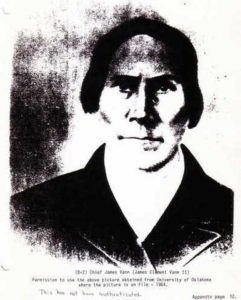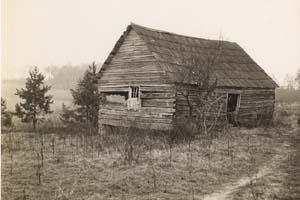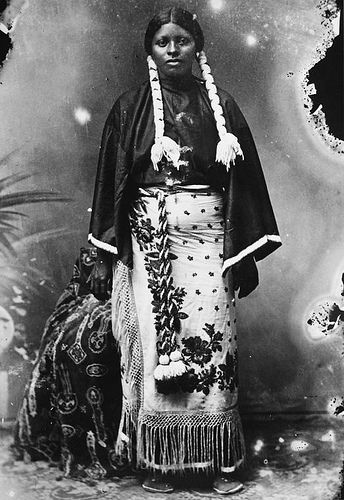While it is true that some Indigenous tribes owned African slaves in the U.S., the story is more complicated that what lies on the surface.
The intersections between African Americans and Indigenous tribes were complex and varied between the slave-holding nations of the southeast; the Cherokee, Creek, Seminole, Choctaw and Chickasaw tribes. Evidence shows diverse treatment included varying degrees of brutality and discrimination, intermarriage and miscegenation, and the cultural interdependence that resulted from colonization and genocide.
Interracial convergence and conflict was also evident in New England, as observed at Connecticut’s Foreign Mission School. Set in Cornwall, Connecticut, The Mission School was intended to be an assimilation school for Native peoples; to abandon their practices, faith and customs and become more to the liking of Anglos. The Mission School was one of hundreds of assimilation schools across the country, an act to commit social death towards Indigenous nations.

After the Revolutionary War, the United States issued a civilization policy which instructed indigenous men to replace hunting and communal lands, to assimilate to the land-ownership paradigm and operate family farms. For the Cherokees, a matrilineal society, assimilating meant women were pushed to diminished domestic circles while their previous agricultural work was replaced with managing plantation slavery. Tension between the federal government and the Native tribes grew in the early 19th century starting with Jefferson. In an effort to be recognized for political independence and land boundaries, the Cherokees drafted a Constitution in 1827. They modeled it after the U.S. Constitution and hoped by speaking in their terms, the Cherokees would be acknowledged as a unified body and an effective nation. The federal government had the exact opposite reaction and perceived this move as a threat. By 1828, Andrew Jackson set the gears in motion for the Indian Removal Act in 1830. Along with the thousands of Natives that were forcibly removed from their homes and plantations, those that had slaves, brought them along on the Trail of Tears to Oklahoma. It’s vital when we discuss the Indian Removal Act and the Trail of Tears, that we remember the Black lives that were subjected to the death march.
Slave-holding tribes held a reputation for being more benevolent to their slaves compared to whites but further investigation reveals there was a broad range of treatment depending on the owner and tribe practices. In the 1830s, the question of racial identity and tribal citizenship was raised. The Choctaw Constitution explicitly stated no one could be in a leadership position unless they were a free male citizen of the Choctaw nation and a descendant of the Choctaw or Chickasaw race. For Cherokees, citizenship was defined as “descendants of Cherokee men by all free women, except the African race…no person who is of negro or mulatto parentage, whether by the father’s or the mother’s side, shall be eligible to hold any office of profit, honor, or trust under this government.”

James Vann, a Cherokee plantation owner adopted white slave-owner practices including corporal punishment and instilled fear with public executions. There is also evidence, however, that he frequently drank and partied with his slaves, thus breaking with some of the traditional practices of a plantation owner. He was also notorious for random acts of brutality. For example, Vann forced his slave, Patience, to walk nearly 375 miles, shoeless. As a result she lost use of her feet and was permanently paralyzed. According to former slave Betty Robertson, Joseph Vann, James’ son, was much more humane in his practices. “Young Master Vann never very hard on us and he never whupped us…maybe old Master Joe Vann was harder, I don’t know, but that was before my time. Young Master never whip his slaves…”
Intermarriage and miscegenation occurred between Natives, whites and slaves. Some slaves were not of the African diaspora. According to freedwoman Sweetie Ivery Wagoner, her father was a Creek Indian stolen by Cherokees and put into slavery. There, he married a Black slave woman and raised eleven children.

At the Foreign Missionary School in Cornwall, Connecticut, John Ridge, a Cherokee student, fell in love with white woman Sarah Northup. Despite both of their families’ protests, the couple returned to his home state of Georgia and married Sarah in 1824. Officials at the Missionary School protested the marriage as well as town residents. When John’s cousin, Elias Boudinot proposed to Harriet Gold, another white woman, the public backlash was so high that efforts were made to make the marriage criminal. Social hierarchy is observed by analyzing the public’s reaction. Miscegenation between Blacks and Natives was not considered as much of a taboo than with a white person.
With that said, as slave populations grew in the Cherokee nation, leaders outlined the status of Black slaves. In 1824, Cherokees passed an ordinance making interracial marriage between Cherokees and slaves illegal. The Creeks and Seminole nations integrated their slaves into tribal life compared to Cherokees, but Cherokees had less restrictions compared to Choctaw and Chickasaw natives. Cherokees intermarried with slaves more frequently prior to the 1824 ordinance. They were also the only tribe to free their slaves before the end of the Civil War. After the War, the Five Tribes had to negotiate new treaties with the federal government and make their former slaves, citizens of the tribal nation. Four of the five tribes complied except the Chickasaws, who refused to give their former slaves full tribal membership.
Influences of European colonization and chattel slavery bled into Native life and culturally impacted everyone involved. Ridge and Boudinot from The Foreign Missionary School applied their education to perpetuate the subjugation of their people. Ridge used his standing with the Cherokees to negotiate with congressmen and President Andrew Jackson. Boudinot went on to be the editor of the Cherokee Phoenix. But they reached deep unpopularity when they were signatories of the Treaty of New Echota; giving Cherokee lands to the U.S. government and advocated for Indian Removal. Both were assassinated in Oklahoma. Surely Ridge and Boudinot could not have anticipated their actions to have triggered the Trail of Tears, but their assimilation impaired their judgment; looking out for white interests rather than their own.
Christian missionaries similar to the Foreign Missionary School popped up all over Native territory in an effort to convert people to Christianity as well as teach English to tribe members and slaves. The Moravian Church had a mission on the property of James Vann, there the intersection of African, German and Cherokee culture collided. The Moravians at the Springplace Mission documented that slaves attended their services at a greater rate than the Cherokees. They also marked their disdain for hearing rituals in the distance, both African and Cherokee, marking that while they utilized the Christian mission services, they retained their indigenous knowledge and traditions. “It was very unpleasant during our worship service…to hear the Negroes’ despicable worship of the devil. There was the continuous thunder of musket, drumming, screaming and dancing that lasted late in the night.”


Some Black and Native people did assimilate to Eurocentric standards, however. Mary Ann Battis, a girl of Creek, Black and white ancestry attended the Asbury Mission School in Alabama. Her story stirred a bit of controversy because at the time of Indian Removal, she chose to stay at the Mission School rather than migrate West with her family. Her light skin and “success” in assimilating to white society worked to her favor and she was able to remain in the Southeast.
While white dominating culture continued to encroach on the territory, some were not exposed to it for quite some time. Freedwoman Lucinda Davis was a slave to a Creek tribe member, only spoke Creek, and didn’t learn English until long after the Civil War. She goes on to describe her life in the Creek nation. Her parents belonged to two different masters but they were able to live together. They worked portions, gave their masters most of what they made and were able to keep some for themselves. They didn’t have to reside on the master’s plantation compared to white, Cherokee and Choctaws, according to her. Following the Civil War, the Creek Agency helped her relocate her parents.
It is important to note that of the hundreds of North American tribes, not all held slaves. The Narragansett, Pequot, Wampanoag, and the Shinnecock also held slaves, in addition to the Five Nations. It is also vital to point out that they were the most influenced by colonization; adapting European practices as a means of survival from their oppressor. And even within the slave-holding nations, there were a number of factions that opposed to the practice as it directly conflicted with their established belief systems. These oppositions came to a head in the beginning of the Civil War. The tribe divided, as Confederate Cherokees and loyal Cherokees took form; these factions endangered the lives of slaves. The rupture of Cherokee unity and subsequent trauma caused by removal in the 1830s, never subsided, and the Civil War brought those schisms to the forefront. Violence dominated the nation and led to Black refugees fleeing Indian Territory.
Applying intersectional theory to Southeast North American territory in the early 19th century, helps illuminate the power dynamics of the time. White men held the most power, they owned vast swaths of land and goods, intermarried into the tribes, imposed their faith practices on others and enacted laws that ultimately led to the deaths of thousands of Native people. The Native tribes and the people of the African diaspora were both subject to the horrors of European colonization. However, with regards to the Cherokee, Chickasaw, Choctaw, Creek and Seminole tribes, Black people possessed less power and autonomy. Evidence of intermarriage, cultural exchange, and varied treatment and practices, however, indicates that life as a Native-American slave, deviates from the dominating narrative of Southern slavery.
For more information on the James Vann estate and the history of Indigenous slaveholders, check out the book, The House on Diamond Hill by Tiya Miles
Source:
Miles, Tiya, The House on Diamond Hill: A Cherokee Plantation Story, (Chapel Hill: University of North Carolina Press, 2010)
T. Lindsay Baker and Julie P. Baker, The WPA Oklahoma Slave Narratives, (University of Oklahoma, 1996), 5.
Linda W. Reese, “Cherokee Freedwomen in Indian Territory, 1863-1890”, Western Historical Quarterly, no. 3 vol. 33 (Autumn 2002): 275-278, accessed September 26, 2018, DOI: 10.2307/4144838
Tiya Miles, “The Lost Letter of Mary Ann Battis: A Troubling Case of Gender and Race in Creek Country”, Native American and Indigenous Studies, no. 1 vol. 1 (Spring 2014): 88-97, accessed September 26, 2018, DOI: 10.5749/natiindistudj.1.1.0088 https://www.jstor.org/stable/10.5749/natiindistudj.1.1.0088.
Zachary Keith and Katherine Hermes, “Love on a Mission,” Connecticut Explored,” 15, no. 1 (Winter 2016-2017) 46-47.
